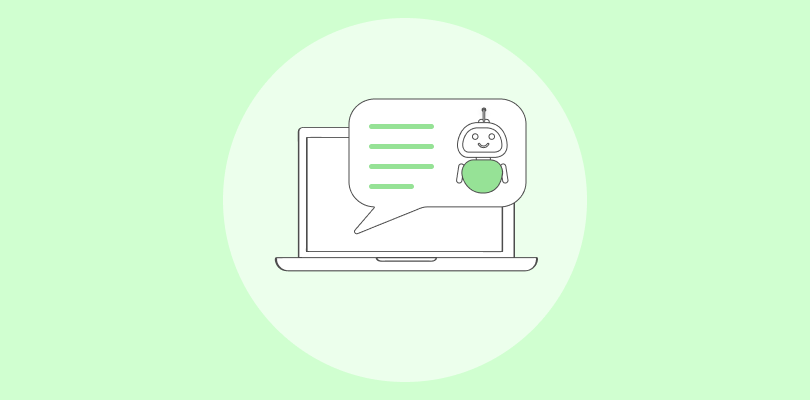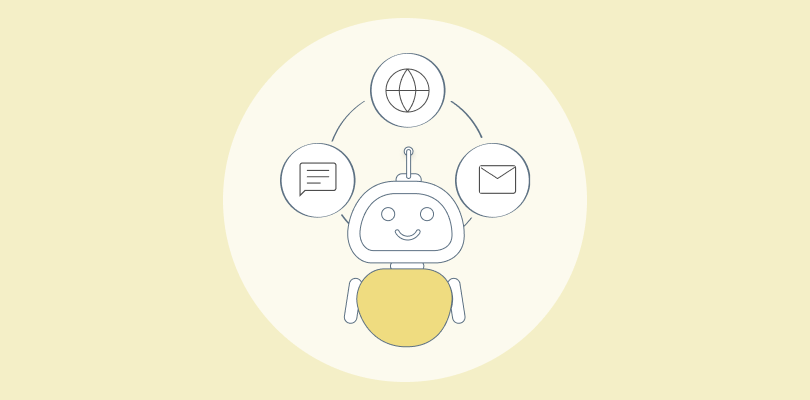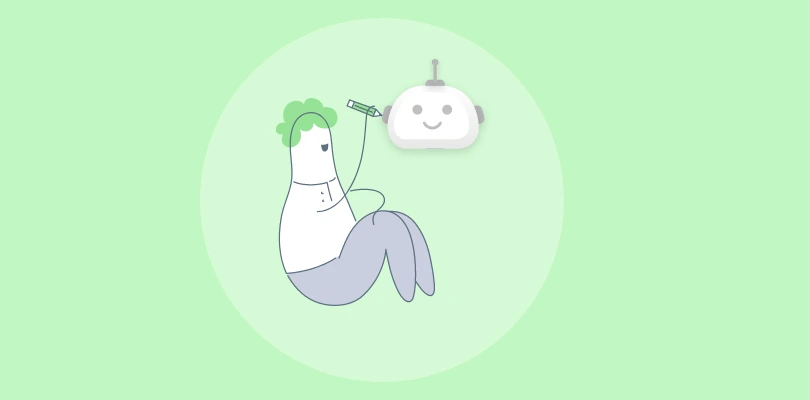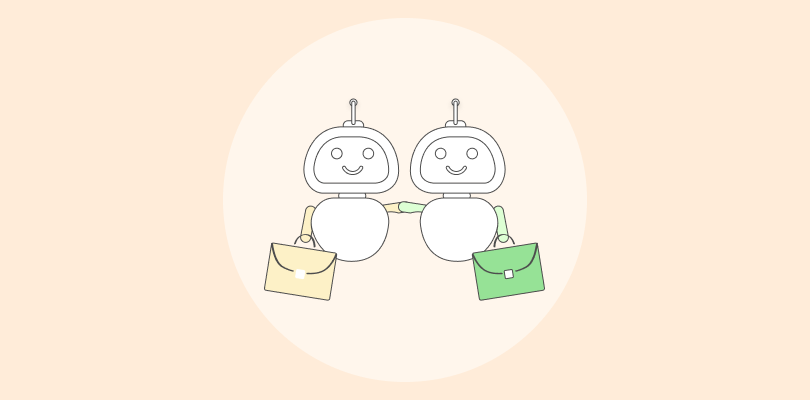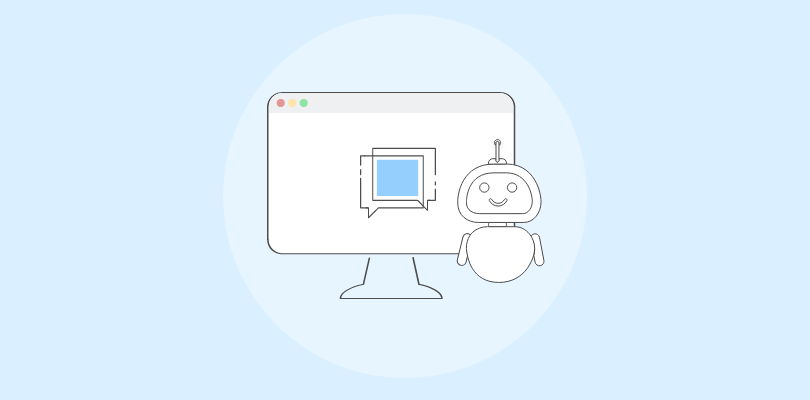Ever wished ordering pizza was as easy as texting a friend? Well, now it is! And you can thank chatbots for that!
Beyond just taking orders, chatbots are now a key player in modern customer service. They’re helping businesses of all sizes provide faster support, handle more inquiries, and ultimately, keep customers happy.
But here’s a catch: not all chatbots are the same. Just like choosing the right pizza toppings, selecting the right chatbot type is essential.
In this blog, we’ll discuss about different types of chatbot, so you can choose the right one to boost efficiency, drive engagement, and keep your customers smiling.
What is a Chatbot?
For those new to the topic, a chatbot is a software application designed to simulate human conversation. It interacts with users through text or voice, answering questions, providing information, and assisting with tasks.
Chatbots are commonly integrated into websites, messaging apps, and customer support platforms to improve user engagement, streamline communication, and offer instant support.
Chatbots can be powered by rule-based systems (simple, pre-programmed responses) or AI-driven models (using machine learning and natural language processing) for more complex interactions.
Whether you’re booking appointments, finding product information, or troubleshooting issues, chatbots offer convenience, efficiency, and round-the-clock assistance.
Now, if you are wondering, “How many types of chatbots are there?” You’ll find the answer in the section below!
What are the Different Types of Chatbots?
Chatbots come in various forms, each tailored to meet specific business needs and user interactions.
Choosing the right type depends on your goals, complexity, and the level of engagement you want with your customers. Here are the different types of chatbots and their key benefits.
1. Menu or Button-Based Chatbots
Menu or button-based chatbots offer users predefined buttons or menus to select their desired actions or information. This simple interface guides users without ambiguity, making interactions quick and efficient.
Often used in FAQs and basic support interactions, these chatbots ensure a seamless experience by minimizing confusion and maximizing clarity, providing instant choices that enhance user satisfaction and engagement.
Benefits:
- Easy to navigate and interact with
- Provides instant answers to common queries
- Ideal for straightforward interactions with low complexity
- Helps users find information without typing
2. Rules-Based Chatbots
Rules-based chatbots operate on a strict set of predefined rules and conditions. They analyze user inputs and respond according to established logic, ensuring structured and accurate interactions. While simple to set up and maintain, they work best for straightforward, predictable tasks.
They are commonly deployed in customer support for handling FAQs and basic inquiries, delivering quick, consistent responses with high reliability.
Benefits:
- Offers uniform responses based on specific inputs
- Requires less advanced development resources
- Best suited for FAQs and basic queries
- Efficiently handles large volumes of standard inquiries
3. AI-Powered Chatbots
AI-powered chatbots use machine learning and natural language processing to understand and respond intelligently. These chatbots offer a more dynamic and personalized user experience, adapting their responses based on context and previous interactions.
They handle complex inquiries, continuously learn from user interactions, and improve over time, providing more sophisticated and relevant support that boosts customer engagement and satisfaction.
Benefits:
- Delivers more human-like responses
- Can handle complex and nuanced queries
- Learns from past interactions over time
- Provides quick and accurate customer support
4. Voice Chatbots
Voice chatbots allow users to communicate through spoken interactions, integrating into devices like smartphones, smart speakers, and call centers. This hands-free communication method enables multitasking and offers convenience.
With real-time voice processing and natural communication, these chatbots facilitate quick interactions and provide a more intuitive and human-like experience, ensuring accessibility and enhancing user engagement across various devices and scenarios.
Benefits:
- Ideal for users who prefer voice interactions
- Enhances multitasking and reduces typing efforts
- Facilitates instant voice-based support
- Creates a dynamic and interactive experience
5. Generative AI Chatbots
Generative AI chatbots use advanced AI models like GPT to create context-aware, unique responses in real-time. They provide a highly personalized interaction experience, adapting to user queries and generating relevant content instantly.
These chatbots scale customer interactions efficiently, handle intricate conversations seamlessly, and continuously improve by learning from new interactions, making them ideal for complex support and content creation tasks.
Benefits:
- Produces more human-like interactions
- Handles a wide variety of user queries effortlessly
- Efficiently scales to support large audiences
- Provides dynamic and context-aware responses
6. Keyword Recognition-Based Chatbots
Keyword recognition-based chatbots rely on identifying specific words in user input to generate responses. They match these keywords to predefined answers and provide quick, relevant interactions. While simple and cost-effective to implement, they are best suited for handling basic inquiries and structured support interactions.
Despite their limitations in complexity, they deliver fast responses and consistent performance in straightforward customer service scenarios.
Benefits:
- Instantly identifies and replies to key inputs
- Simple to develop and deploy
- Easily handles repetitive, keyword-driven interactions
- Offers quick solutions for common queries
7. Hybrid Chatbots
Hybrid chatbots combine the strengths of both AI-driven and rules-based approaches, delivering a balanced and adaptable solution. They handle both simple and complex interactions efficiently by leveraging predefined rules and intelligent AI capabilities.
This combination ensures optimal response accuracy and scalability while providing personalized user experiences. Hybrid chatbots are ideal for businesses seeking flexibility and seamless integration across various customer interaction channels and support scenarios.
Benefits:
- Merges the scalability of AI with structured rules
- Provides accurate responses for complex queries
- Adaptable to different business interactions and use cases
- Balances automation with human intervention when needed
Top 6 Chatbot Use Cases Across Different Industries
Chatbots are no longer a futuristic fantasy; they’re reshaping business processes across industries. From answering customer queries to scheduling appointments, these AI-powered assistants are proving their worth. Let’s explore the top 7 chatbot use cases across different sectors:
1. eCommerce
Need help finding the perfect product at 3 AM? No problem! Chatbots in eCommerce provide round-the-clock support, answering product questions, guiding customers through purchases, and even offering personalized recommendations.
This enhances the customer experience by providing instant support, reducing cart abandonment, and ultimately boosting sales. By automating tasks like order tracking and returns, chatbots free up human agents to focus on more complex issues.
2. Automotive
The automotive industry is getting a digital makeover with chatbots. They can schedule test drives, answer technical questions about specific models, and even help diagnose car problems.
This provides instant support to potential buyers, guides them through vehicle features, and streamlines the customer journey for enhanced satisfaction.
3. Education
Chatbots are revolutionizing education by acting as personalized tutors available at any time. They can answer student questions, provide feedback on assignments, and even offer customized study plans.
This allows for a more individualized learning experience. By automating administrative tasks like enrollment and scheduling, chatbots free up educators to focus on what they do best: teaching.
4. Healthcare
Healthcare is becoming more accessible with chatbots that act as virtual nurses. Available 24/7, they can answer health questions, schedule appointments, and even provide medication reminders.
This improves patient access to care, reduces wait times, and streamlines administrative tasks. They can also assist with mental health support, offering a safe space for patients to discuss their concerns.
5. Real Estate
Finding your dream home just got easier thanks to the real estate chatbots. They can answer property inquiries, schedule viewings, and even guide buyers through the mortgage process. This allows real estate agents to focus on closing deals by automating tasks like lead generation and property matching.
6. Travel
Planning a vacation? Chatbots can be your virtual travel agents, helping you book flights, find hotels, and even suggest personalized itineraries. They provide instant support to travelers, answer questions about destinations, and offer real-time travel updates. This enhances the travel experience by automating tasks like booking and customer service.
These are just a few examples of how chatbots are being used across different industries. As technology continues to evolve, we can expect even more innovative applications of chatbots in the future.
How to Choose the Best Chatbot for Your Business
Choosing the best chatbot for your business involves considering multiple factors that ensure it meets your needs and drives value. Here are six key factors to keep in mind:
1. Business Goals and Use Cases
First and foremost, you need to align the chatbot’s features with your business goals and specific use cases. Are you looking to automate customer support, boost sales, or streamline lead generation? Some chatbots excel at providing immediate customer assistance, while others are tailored for sales, booking appointments, or even post-sale follow-ups.
Understanding your objectives will help you select a chatbot that can effectively address the tasks you need it to perform, ultimately enhancing the customer experience and increasing operational efficiency.
2. Ease of Use and Integration
The chatbot should be user-friendly, both for your team and customers. A complicated setup or maintenance process can waste valuable time and resources. Look for a platform with an intuitive interface, minimal coding requirements, and seamless integration with your existing tools (CRM systems, marketing platforms, etc.).
The chatbot should easily integrate with your website, social media channels, and any other tools your business uses. This ensures smooth data flow and helps you avoid silos, which can hinder your ability to deliver a seamless customer experience.
3. Customization and Personalization
Personalization is crucial in modern business interactions. The best chatbot should allow you to customize the conversation flow to reflect your brand’s voice and cater to your customer’s unique needs. Plus, look for chatbots that enable advanced personalization, such as adapting responses based on user behavior, preferences, and historical interactions.
This helps create a more engaging and human-like experience, making customers feel valued and understood, which can significantly boost customer satisfaction and retention.
4. AI and NLP Capabilities
The artificial intelligence (AI) and natural language processing (NLP) capabilities of a chatbot are essential for delivering an intelligent and dynamic interaction. The more advanced the AI, the better the bot can understand and respond to customer queries in a natural, conversational manner.
Choose a chatbot with strong NLP capabilities that can comprehend a wide range of customer inputs, including slang, typos, and complex questions. This will enhance its ability to provide accurate answers and resolve issues, reducing customer frustration and improving overall satisfaction.
5. Scalability and Flexibility
Your business will evolve over time, and so should your chatbot. It’s important to choose a chatbot that can scale with your business as it grows. Whether you’re expanding your product line, increasing customer volume, or expanding to new markets, the chatbot should be flexible enough to handle increased demand without compromising performance.
Consider chatbots that offer features such as multi-language support, the ability to add new channels, and the flexibility to adjust workflows as your business needs change.
6. Cost-Effectiveness and ROI
Finally, ensure that the chatbot you select provides value for money and fits within your budget. While some chatbot platforms may offer basic features at a low cost, others may come with advanced functionalities that justify a higher price. It’s important to assess the long-term return on investment (ROI).
Calculate how much time and resources the chatbot will save, and consider the potential for increased sales, improved customer support, and higher customer retention. Compare the features and pricing of different chatbots to determine the best fit for your budget and business needs.
FREE. All Features. FOREVER!
Try our Forever FREE account with all premium features!
Boost Customer Engagement & Support With the Right Chatbot Type
If you’re curious about what types of chatbots are there, understanding the different categories can help you make the right choice for your business. Each chatbot type, from rule-based to AI-driven, offers unique capabilities tailored to specific goals and needs.
When implementing a chatbot, consider your objectives, audience, and industry requirements. Prioritize features like user-friendly interfaces, multilingual support, and customizable workflows to ensure a seamless experience.
With ProProfs Chat, you can easily create and configure AI-powered chatbots, train them using your help center data, and effortlessly automate customer support 24/7.
Learn More About AI Chatbots: FAQs
How much do chatbots cost?
The cost of chatbots can vary widely depending on their complexity, features, and customization. Several platforms, such as Pro Profs Chat, offer a free plan for smaller teams, making it easier for businesses with limited budgets to get started. As your business grows or if you require more advanced features, paid plans are available.
Do I need a technical team to manage a chatbot?
No, most chatbot platforms offer user-friendly interfaces with drag-and-drop builders and intuitive tools that don’t require technical expertise. Many solutions allow you to set up, customize, and manage your chatbot with ease, often through simple point-and-click functionality.
Can chatbots handle multiple languages?
Yes, many chatbots support multiple languages, often 70+ languages, enabling businesses to communicate effectively with a global audience. This ensures a seamless experience for users, regardless of language barriers.
Can chatbots be customized for different industries?
Absolutely! Chatbots can be tailored to meet the specific needs of various industries, such as e-commerce, healthcare, finance, education, and customer support. Customizations include unique workflows, branding, conversation templates, and integrations that align with your business requirements and objectives.
FREE. All Features. FOREVER!
Try our Forever FREE account with all premium features!

 We'd love your feedback!
We'd love your feedback!
 Thanks for your feedback!
Thanks for your feedback!


